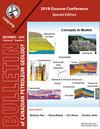Introduction to the Special Edition from the 2014 Gussow Conference on Advances in Applied Geomodeling
Q3 Earth and Planetary Sciences
引用次数: 0
Abstract
Geomodeling has proliferated among earth science and engineering professionals as a body of techniques, software packages, and workflows for subsurface reservoir characterization. Although not a recognized professional discipline or university degree option, geomodeling is a multidisciplinary subject with a growing technical community. Geomodeling is treated as an enabling technical field and focal point in the petroleum industry subsurface teams, with major software development dedicated to the subject and practitioners assuming the role and title. The broad subject typically draws from the fields of geology, geophysics, geostatistics, petrophysics, reservoir engineering, and increasingly geomechanics, computer science, and data analytics. The field of geostatistics is a fundamental aspect of geomodeling, providing many core algorithms. The other associated fields provide concepts, context, inputs, constraints, and direction for the technology applications and for multidisciplinary team efforts to deliver meaningful models and results. The motivation for companies is to pursue exploration, development, and production with increased efficiency and sustainability. The geomodeling proposition is to add value through improved reservoir management decisions. More accurate and precise geomodels lead to improved well planning and prediction of the behavior of alternative extraction technologies. Thus, geomodeling will improve recovery and reduce risk. Yet, gaps exist between the application of geomodeling, geostatistical methods, capabilities of software tools, and appropriate practice and ease of use. With …2014年古索应用地质建模进展会议特别版简介
地质建模作为地下储层表征的技术、软件包和工作流程的主体,在地球科学和工程专业人员中得到了广泛的应用。虽然不是一个公认的专业学科或大学学位的选择,地质建模是一个多学科学科与不断增长的技术社区。地质建模被视为石油工业地下团队的一个技术领域和焦点,主要的软件开发致力于该主题,从业者承担角色和头衔。这一广泛的学科通常涉及地质学、地球物理学、地质统计学、岩石物理学、油藏工程以及越来越多的地质力学、计算机科学和数据分析等领域。地质统计学领域是地质建模的一个基本方面,提供了许多核心算法。其他相关的领域为技术应用程序和多学科团队提供概念、上下文、输入、约束和方向,以交付有意义的模型和结果。公司的动机是追求更高效率和可持续性的勘探、开发和生产。地质建模的主张是通过改进油藏管理决策来增加价值。更准确和精确的地质模型可以改善井的规划和预测替代开采技术的行为。因此,地质建模将提高采收率并降低风险。然而,在地质建模、地质统计方法的应用、软件工具的能力、适当的实践和易用性之间存在差距。与…
本文章由计算机程序翻译,如有差异,请以英文原文为准。
求助全文
约1分钟内获得全文
求助全文
来源期刊

Bullentin of Canadian Petroleum Geology
Earth and Planetary Sciences-Geochemistry and Petrology
CiteScore
2.50
自引率
0.00%
发文量
0
期刊介绍:
The Bulletin of Canadian Petroleum Geology is a peer-reviewed scientific journal published four times a year. Founded in 1953, the BCPG aims to be the journal of record for papers dealing with all aspects of petroleum geology, broadly conceived, with a particularly (though not exclusively) Canadian focus. International submissions are encouraged, especially where a connection can be made to Canadian examples.
 求助内容:
求助内容: 应助结果提醒方式:
应助结果提醒方式:


